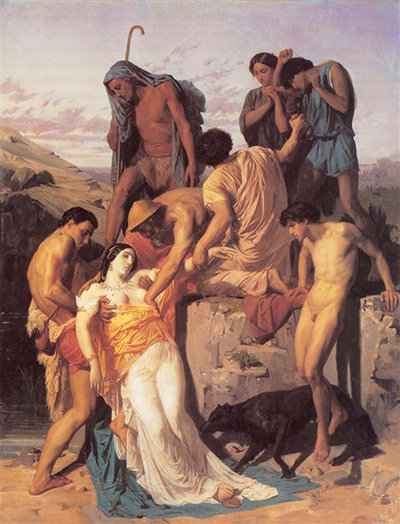The piece Zenobia found by Shepherds on the Banks of the Araxes was created by William Bouguereau and consequently won the Prix de Rome in the year 1850. This achievement allowed him to stay in Rome at the Villa Medici for a total of four years.
Zenobia found by Shepherds on the Banks of the Araxes portrays a group of shepherds who have discovered Zenobia half dead, washed up by the stream. Zenobia was married to Rhadamistus, who murdered the royal family of Armenia (Zenobia's relatives) before taking her as his wife. Unfortunately, the Armenians eventually uprose against this power and the two had to flee.
In an effort to not be captured in shame, Zenobia pleaded for her husband to kill her in an action of mercy. Rhadamistus stabbed his pregnant wife and let the stream carry her body away. Still alive, she was discovered by the shepherds.
Due to this experience, Bouguereau painted Zenobia as fragile, weak and very close to death. She is tired and her clothes are a mess due to the travel in the stream after being stabbed. The shepherds who discover her realise that she is at least a noble woman due to the cloth she is wearing and the expensive jewellery she has on. It is mostly because of this that they attempt to rescue her.
Zenobia looks very exhausted. Her garments have draped off of her shoulders to expose her breasts, possibly to note her pregnancy. The boy on the right of the picture seems captured by Zenobia, either because of her beauty or due to her weakness.
The shepherds tactically lift her in the best way possible. They do not treat her with delicacy despite her gender and status, but more so are concerned with her health. The shepherd on the left of the picture has placed his knee behind her in order to be able to lift her up. A shepherd donning a hat has hold of her with one hand and is keeping a wound concealed with the other.
A third shepherd is helping Zenobia, grasping her left arm whilst trying to provide her with a drink to assist her. There is only one other woman in this painting, perhaps a daughter or wife who looks on rather anxiously with a worried expression for Zenobia, or perhaps the sheer discovery of her. There is also a dog along with the party who curiously is sniffing at Zenobia, trying to aquaint itself with this stranger.




